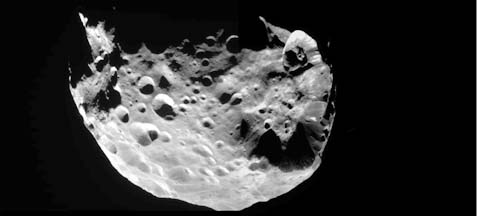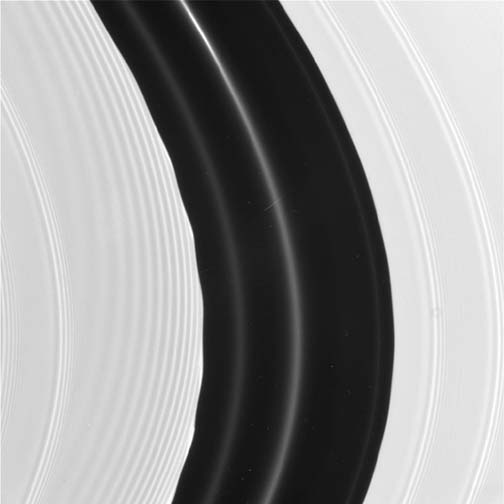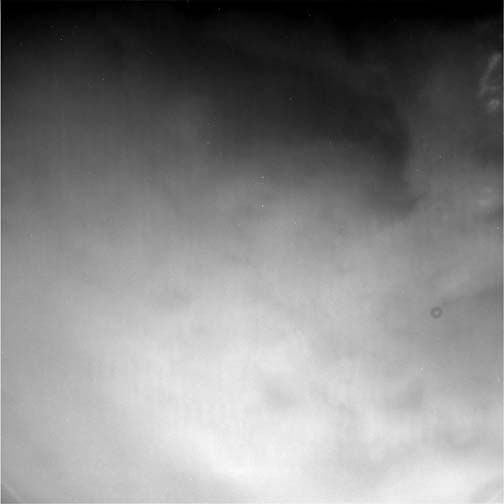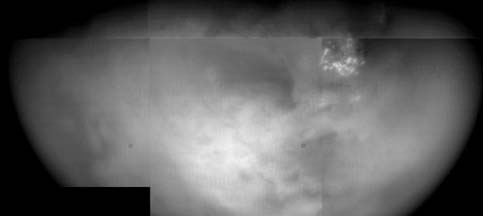 The small moon Phoebe was the first close encounter of the Cassini-Huygens
probe as it entered the realm of Saturn. Closest passage occurred on June 11.
The small moon Phoebe was the first close encounter of the Cassini-Huygens
probe as it entered the realm of Saturn. Closest passage occurred on June 11.
 The small moon Phoebe was the first close encounter of the Cassini-Huygens
probe as it entered the realm of Saturn. Closest passage occurred on June 11.
The small moon Phoebe was the first close encounter of the Cassini-Huygens
probe as it entered the realm of Saturn. Closest passage occurred on June 11.
 This is a composite of two frames of Phoebe, taken on June 11 when the Cassini-Huygens
probe was about 20,000 miles from the moon.
This is a composite of two frames of Phoebe, taken on June 11 when the Cassini-Huygens
probe was about 20,000 miles from the moon.
On July 1, after nearly seven years in transit, the Cassini-Huygens probe fired its rocket engine for over an hour and half to place it into orbit around Saturn.
Check the Cassini-Huygens web site to see the most detailed images ever made of Saturn's rings. See density waves, bending waves, the scalloped edge of the Encke Gap, and strange never before seen slashes across one of the strands of the F-ring.
 I stitched together sixteen raw frames that were taken on June 19
to make this composite of the rings. It links
to a full resolution version that is almost 7,400 pixels wide. Cassini was about 6,400,000 km
from Saturn when the exposures were made. Look for tiny ring shepherding moons and the
shadows of the rings on the planet.
I stitched together sixteen raw frames that were taken on June 19
to make this composite of the rings. It links
to a full resolution version that is almost 7,400 pixels wide. Cassini was about 6,400,000 km
from Saturn when the exposures were made. Look for tiny ring shepherding moons and the
shadows of the rings on the planet.
 Here is the same composite image after processing to enhance detail in the rings. Saturn is
much brighter than its rings, so detail on the surface of the planet was lost.
Here is the same composite image after processing to enhance detail in the rings. Saturn is
much brighter than its rings, so detail on the surface of the planet was lost.
 Here is the same composite image after processing to preserve detail on
the surface of the planet, resulting in reduced contrast in the rings.
Here is the same composite image after processing to preserve detail on
the surface of the planet, resulting in reduced contrast in the rings.
 This image of the Encke Gap in the A-ring was taken on July 1 from a distance of about
86,000 miles after the second passage through the plane of the rings. The narrow rings
in the gap are
constrained by small moons that are also orbiting in the gap. The four sets of small bands are
density waves. They are formed by the gravitational influence of the larger moons orbiting
outside the rings. For every x times that this part of the ring revolves around Saturn,
some moon goes around y times. The repeated interactions at periodic intervals produces
a spiral wave pattern in the rings. If you trace one of those bands all the way around
the rings it connects to the next band.
This image of the Encke Gap in the A-ring was taken on July 1 from a distance of about
86,000 miles after the second passage through the plane of the rings. The narrow rings
in the gap are
constrained by small moons that are also orbiting in the gap. The four sets of small bands are
density waves. They are formed by the gravitational influence of the larger moons orbiting
outside the rings. For every x times that this part of the ring revolves around Saturn,
some moon goes around y times. The repeated interactions at periodic intervals produces
a spiral wave pattern in the rings. If you trace one of those bands all the way around
the rings it connects to the next band.
What freaks me out is the distinctly our of round inner edge of the gap and the tightly wound spiral waves in the ring just inside the gap. If you trace one of those bands just a short way around the rings, there are several bands between it and the edge of the gap. None of the ring scientists I have seen on NASA TV have been able to explain what's going on there.
This is really cool stuff. The raw images make it possible to ponder phenomena that nobody understands yet.
My theory, which is mine, which I call My Theory, is this: The scalloped edge results from a resonance between the little moons orbiting inside the Encke Gap. At periodic intervals the little moons are right next to each other. Their combined gravitational influence then creates one of those funky bulges and a spiral wave.
But that's probably not right.
Cassini made a close approach to Titan at 3:45 A.M. PDT on Friday July 3. It came within 205,000 miles of the moon with the densest atmosphere of any moon in the solar system. By viewing in the infra-red and using a polarizer the raw images of Titan made during the flyby revealed unprecedented surface detail. There are fascinating features visible that have yet to be explained.
 This image shows some patches that are very
reflective in the infra-red. It is thought that they may be cumulus clouds composed of
methane. Notice how the surface details become less distinct near the limb of Titan
where the camera has to look through more of the haze in the atmosphere.
This image shows some patches that are very
reflective in the infra-red. It is thought that they may be cumulus clouds composed of
methane. Notice how the surface details become less distinct near the limb of Titan
where the camera has to look through more of the haze in the atmosphere.
 This image shows a broad dark area area just to the left of the image above.
There is no sign of large bodies of liquid methane, which would appear bright in images made
in the infra-red.
This image shows a broad dark area area just to the left of the image above.
There is no sign of large bodies of liquid methane, which would appear bright in images made
in the infra-red.
 This six-frame composite image is made of raw images taken on July 3 when the
Cassini-Huygens probe was about 210,000 miles from Titan.
This six-frame composite image is made of raw images taken on July 3 when the
Cassini-Huygens probe was about 210,000 miles from Titan.
 This is the same composite after processing to improve contrast.
This is the same composite after processing to improve contrast.
Cassini is also collecting radar data that will refine our knowledge of the surface topography of the large moon/small planet.
Beginning tonight, Saturn will be passing on the far side of the sun, making communication with the Cassini-Huygens probe impossible until July 12.
On December 24, the Huygens probe will be released from Cassini to investigate Titan and its dense nitrogen atmosphere. Huygens will enter Titan's atmosphere on January 14, 2005.
The Cassini-Huygens web site has posted all the raw images from the Cassini-Huygens probe. More raw images are being added to their web site as soon as they are received.
Send a message to Brian.